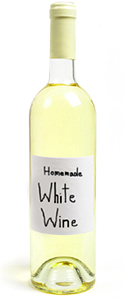 In this last post of a III part series we’ll go over the importance of using sodium metabisulfte when racking you wines.
In this last post of a III part series we’ll go over the importance of using sodium metabisulfte when racking you wines.
Keeping air exposure to a minimum also means that great care should be taken when racking your wine. Eliminate as much splashing as possible. Splashing will only introduce more air into the wine. You can do this by making sure the siphon hose fills the wine carboy or vessel from the bottom up. In other words, keep the end of the hose down into the wine as it is filling up the wine carboy.
Also, for rackings that are done after the fermentation has completed, sodium metabisulfite should be added directly into the wine. If the fermentation is not complete, sodium metabisulfite should not be added. It could interfere with the fermentation or wine brewing.
Sodium metabisulfite will release sulfur dioxide gas (SO2) into the wine driving out any oxygen that may have saturated into the wine during racking. As an added bonus it will also destroy any unwanted microorganism that may have gotten into the wine as well.
Because much of SO2 naturally wants to leave or dissipate from the wine it needs to be replenished at every racking. Unless you have a way of testing for sulfur dioxide (SO2) levels, how much to add can be somewhat of a guessing game. I normally add half of a full dose at rackings. This comes out to 3/16 of a teaspoon for a 6 gallon batch of wine, or 1 teaspoon to every 32 gallons of wine.
We have titration kit that is used to measure the level of SO2 in a wine at any given time. This is the most accurate way to go, and it is also what I would recommend doing if you have a larger batch of wine at stake.
The titration kit measures SO2 in parts-per-million or (P.P.M.). During rackings you would like the wine to maintain a level of SO2 at about 30 P.P.M. At bottling time you would like to raise this level to about 50 to 60 P.P.M. This is the same level found in commercially made wines.
Having this level of SO2 in the wine while it is in the wine bottle will protect it from spoilage and help to keep it stable. Eliminating this step does not mean that your wine will immediately show signs of oxidation, however it will be much more susceptible to it.
———————————————————————————————————
Ed Kraus is a 3rd generation home brewer/winemaker and has been an owner of E. C. Kraus since 1999. He has been helping individuals make better wine and beer for over 25 years.
